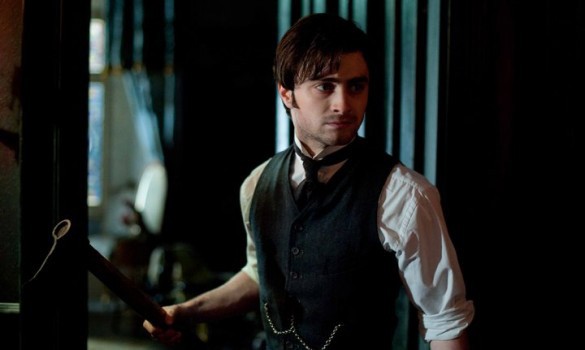The Woman in Black
The Woman in Black, 2012, 3 ½ stars
Black is back
From The Orlando Weekly, February 3, 2012
Forget Harry Potter. Forget even Daniel Radcliffe. Though he has been the focus of the publicity for the new adaptation of The Woman in Black, he is not the star – the film itself is. And that’s how it should be, as director James Watkins allows the images and sounds to dominate this haunted-house horror, the scariest such film since Bayona’s El Orfanato (The Orphanage), five years ago.
Based on the 1983 book by Susan Hill, the movie tells of a young lawyer sent to an isolated English village around the turn of the last century to organize the estate of a woman who has recently passed. What the solicitor hasn’t been told is that the house, and the family who lived, and died, there, have seemingly laid a curse on the town.
The book inspired not just an excellent 1989 British TV movie but also a successful London play that opened that same year – and is still running. (Only Agatha Christie’s The Mousetrap has run longer in the West End.) I saw it several years ago, and while it was certainly worthwhile, it didn’t seep into the brain the way a Gothic ghost story should. Cinema, after all, is more suited to horror because the director and cinematographer can tell you where and how to look while the theatre director is powerless in that regard. The latter can direct his actors – but not his audience.
Watkins clearly understands this power of manipulation and exercises it well, especially for a director with just one major credit to his name prior to Woman. (He helmed the well-received 2008 British horror Eden Lake, although that film was far bloodier and more modern.) Despite his inexperience with this genre, or maybe because of it, Watkins feels the need to lean on – superbly but perhaps a tad too heavily – every classic horror-movie trick. He employs creepy siblings out of The Shining, jarring suicides inspired by The Omen, spooky mediums and self-moving doors from The Others, audio terror courtesy of Robert Wise’s The Haunting – and even a surreal talking bird thanks to The Third Man. And let’s not leave out the creepiest mechanical toys this side of Joseph Mankiewicz’s Sleuth.
Surprisingly, the failings of Woman, which threaten to derail it in the third act, are ones of plot, not style. Departing unnecessarily from the previous versions, Jane Goldman’s screenplay takes a brief, odd turn, stretching believability and lessening the remarkable tension that Watkins has built. It’s not that the film has been realistic until that point – it is, admittedly, a ghost yarn – but it has at least been true to itself. Movies, after all, aren’t about creating realism; they are about making you believe the unrealistic is real.
“If we open the door to superstition, where does that lead?” asks the one villager (an excellent Ciaran Hinds) who befriends Radcliffe’s character. In this instance, and despite the failings of the script, it clearly leads to terror.
© 2012 Orlando Weekly / MeierMovies, LLC
